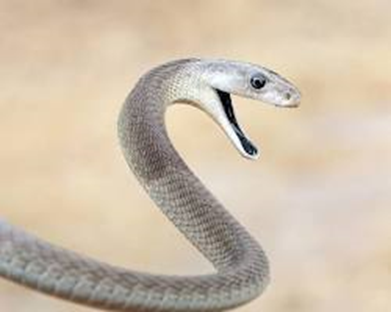South Africa is home to a variety of venomous
snakes, some of which are among the most dangerous in the world. It is
important to be aware of these snakes when spending time outdoors in South
Africa, so that you can take steps to avoid them and seek medical attention
immediately if you are bitten.
Here
are some of the most common poisonous snakes in South Africa:
·
Black mamba (Dendroaspis
polylepis): The black mamba is
Africa's largest venomous snake and can grow up to 4.5 meters long. It is also
one of the fastest snakes in the world, capable of moving at speeds of over 20
km/h. Black mambas are found in the eastern and northern regions of South Africa.
·
Puff adder (Bitis arietans): The puff adder is a heavy-bodied snake with
a triangular head and a distinctive zigzag pattern on its back. It is found
throughout South Africa and is responsible for more snakebite deaths than any
other snake in the country. Puff adders are slow-moving, but they are also very
aggressive and can strike without warning.
·
Boomslang (Dispholidus typus): The boomslang is a tree-dwelling snake with
a slender body and large eyes. It is found throughout South Africa, except for
the Northern Cape. Boomslang venom is highly potent and can cause delayed-onset
bleeding and organ failure.
· Cape cobra (Naja nivea): The Cape cobra is a common snake in the Western Cape province of South Africa. It is a medium-sized snake with a slender body and a triangular head. Cape cobra venom is neurotoxic and can cause paralysis and death.
·
Mozambique spitting cobra (Naja
mossambica): The Mozambique
spitting cobra is found in the eastern and northern regions of South Africa. It
is known for its ability to spit venom at its attackers. Mozambique spitting
cobra venom can cause severe eye damage and blindness.
If you are bitten by a snake in South Africa, it is important to seek medical attention immediately. Antivenom is available for all of the venomous snakes in South Africa, but it is most effective if administered as soon as possible.
Here
are some tips to help you avoid snakebites in South Africa:
·
Be aware of your
surroundings and watch out for snakes when walking or hiking in areas where
they are known to occur.
·
Wear sturdy shoes and
long pants to protect yourself from snake bites.
·
Avoid putting your
hands in holes or under rocks, where snakes may be hiding.
· If you see a snake, do not approach it. Back away slowly and leave it alone.





Comments
Post a Comment